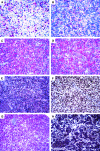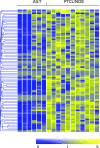Peripheral T cell lymphoma, not otherwise specified: the stuff of genes, dreams and therapies
- PMID: 18755717
- PMCID: PMC2582342
- DOI: 10.1136/jcp.2008.055335
Peripheral T cell lymphoma, not otherwise specified: the stuff of genes, dreams and therapies
Abstract
Peripheral T cell lymphomas (PTCL) account for about 12% of lymphoid tumours worldwide. Almost half show such morphological and molecular variability as to hamper any further classification, and to justify their inclusion in a waste-basket category termed "not otherwise specified (NOS)". The latter term is used for neoplasms with aggressive presentation, poor response to therapy and dismal prognosis. In contrast to B cell lymphomas, PTCL have been the subject of only a limited number of studies to elucidate their pathobiology and identify novel pharmacological approaches. Herewith, the authors revise the most recent contributions on the subject based on the experience they have gained in the extensive application of microarray technologies. PTCL/NOS are characterised by erratic expression of T cell associated antigens, including CD4 and CD52, which have recently been proposed as targets for ad hoc immunotherapies. PTCL/NOS also show variable Ki-67 marking, with rates >80% heralding a worse prognosis. Gene expression profiling studies have revealed that PTCL/NOS derive from activated T lymphocytes, more often of the CD4+ type, and bear a signature composed of 155 genes and related products that play a pivotal role in cell signalling transduction, proliferation, apoptosis and matrix remodelling. This observation seems to pave the way for the use of innovative drugs such as tyrosine kinase and histone deacetylase inhibitors whose efficacy has been proven in PTCL primary cell cultures. Gene expression profiling also allows better distinction of PTCL/NOS from angioimmunoblastic T cell lymphoma, the latter being characterised by follicular T helper lymphocyte derivation and CXCL13, PD1 and vascular endothelial growth factor expression.
Conflict of interest statement
Figures


Similar articles
-
Molecular understanding of peripheral T-cell lymphomas, not otherwise specified (PTCL, NOS): A complex disease category.J Clin Exp Hematop. 2021 Jun 5;61(2):61-70. doi: 10.3960/jslrt.20059. Epub 2021 Mar 15. J Clin Exp Hematop. 2021. PMID: 33716242 Free PMC article. Review.
-
Expression of follicular helper T cell markers in nodal peripheral T cell lymphomas: a tissue microarray analysis of 162 cases.J Clin Pathol. 2011 Apr;64(4):319-24. doi: 10.1136/jcp.2010.084459. Epub 2011 Feb 17. J Clin Pathol. 2011. PMID: 21330314
-
Peripheral T-cell lymphoma--not otherwise specified.Crit Rev Oncol Hematol. 2011 Sep;79(3):321-9. doi: 10.1016/j.critrevonc.2010.07.007. Epub 2010 Aug 10. Crit Rev Oncol Hematol. 2011. PMID: 20702104 Review.
-
Pathobiology and molecular profiling of peripheral T-cell lymphomas.Hematology Am Soc Hematol Educ Program. 2008:272-9. doi: 10.1182/asheducation-2008.1.272. Hematology Am Soc Hematol Educ Program. 2008. PMID: 19074096
-
Molecular profiling improves classification and prognostication of nodal peripheral T-cell lymphomas: results of a phase III diagnostic accuracy study.J Clin Oncol. 2013 Aug 20;31(24):3019-25. doi: 10.1200/JCO.2012.42.5611. Epub 2013 Jul 15. J Clin Oncol. 2013. PMID: 23857971 Clinical Trial.
Cited by
-
SNPs Array Karyotyping in Non-Hodgkin Lymphoma.Microarrays (Basel). 2015 Nov 12;4(4):551-69. doi: 10.3390/microarrays4040551. Microarrays (Basel). 2015. PMID: 27600240 Free PMC article. Review.
-
Mast cells and Th17 cells contribute to the lymphoma-associated pro-inflammatory microenvironment of angioimmunoblastic T-cell lymphoma.Am J Pathol. 2010 Aug;177(2):792-802. doi: 10.2353/ajpath.2010.091286. Epub 2010 Jul 1. Am J Pathol. 2010. PMID: 20595635 Free PMC article.
-
Molecular genetics of peripheral T-cell lymphomas.Int J Hematol. 2014 Mar;99(3):219-26. doi: 10.1007/s12185-014-1522-1. Epub 2014 Jan 31. Int J Hematol. 2014. PMID: 24481943 Review.
-
[Primary cutaneous peripheral T-cell lymphoma (not otherwise specified)].Hautarzt. 2011 May;62(5):332-5. doi: 10.1007/s00105-011-2164-3. Hautarzt. 2011. PMID: 21437704 German.
-
Burrowing through the Heterogeneity: Review of Mouse Models of PTCL-NOS.Front Oncol. 2016 Sep 26;6:206. doi: 10.3389/fonc.2016.00206. eCollection 2016. Front Oncol. 2016. PMID: 27725924 Free PMC article. Review.
References
-
- Jaffe E S, Harris N L, Stein H, Vardiman J W, eds. Pathology and genetics: tumours of haematopoietic and lymphoid tissues (World Health Organization Classification of Tumours). Lyon: IARC Press, 2001
-
- Zucca E, Zinzani PL. Understanding the group of peripheral T-cell lymphomas, unspecified. Curr Hematol Rep 2005;4:23–30 - PubMed
-
- Harris NL, Jaffe ES, Stein H, et al. A revised European–American classification of lymphoid neoplasms: a proposal from the International Lymphoma Study Group. Blood 1994;84:1361–92 - PubMed
-
- Evens AM, Gartenhaus RB. Treatment of T-cell non-Hodgkin’s lymphoma. Curr Treat Options Oncol 2004;5:289–303 - PubMed
-
- Lopez-Guillermo A, Cid J, Salar A, et al. Peripheral T-cell lymphomas: initial features, natural history, and prognostic factors in a series of 174 patients diagnosed according to the REAL Classification. Ann Oncol 1998;9:849–55 - PubMed
Publication types
MeSH terms
Substances
LinkOut - more resources
Full Text Sources
Research Materials
